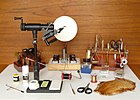Related Research Articles

The Madison River is a headwater tributary of the Missouri River, approximately 183 miles (295 km) long, in Wyoming and Montana. Its confluence with the Jefferson and Gallatin rivers near Three Forks, Montana forms the Missouri River.

Recreational fishing, also called sport fishing or game fishing, is fishing for leisure, exercise or competition. It can be contrasted with commercial fishing, which is professional fishing for profit; or subsistence fishing, which is fishing for survival and livelihood.

The cutthroat trout(Oncorhynchus clarkii) is a fish species of the family Salmonidae native to cold-water tributaries of the Pacific Ocean, Rocky Mountains, and Great Basin in North America. As a member of the genus Oncorhynchus, it is one of the Pacific trout, a group that includes the widely distributed rainbow trout. Cutthroat trout are popular gamefish, especially among anglers who enjoy fly fishing. The common name "cutthroat" refers to the distinctive red coloration on the underside of the lower jaw. The specific name clarkii was given to honor explorer William Clark, coleader of the Lewis and Clark Expedition.

The Firehole River is located in northwestern Wyoming, and is one of the two major tributaries of the Madison River. It flows north approximately 21 miles (34 km) from its source in Madison Lake on the Continental Divide to join the Gibbon River at Madison Junction in Yellowstone National Park. It is part of the Missouri River system.

The Woolly Bugger is an artificial fly commonly categorized as a wet fly or streamer and is fished under the water surface. It is a popular and widely used pattern for both freshwater and saltwater game fish and is generally listed as one of the top patterns to have in any fly box. John Gierach, a noted fly fishing writer discussed the Woolly Bugger first in his chapter on streamers in Good Flies. Woolly Buggers are typically fished in streams, rivers, ponds, lakes, and tidal flats. Today, Woolly Buggers are tied in a wide variety of styles and colors to imitate a wide range of game fish prey.
The Woolly Bugger is so effective, it should be banned from some watersheds. I suspect its effectiveness is due to its resemblance to so many edible creatures in the water—nymphs, leeches, salamanders, or even small sculpins. Its tail undulating behind a fiber, bubble-filled body is just too much for most fish to resist. It just looks like a meal!
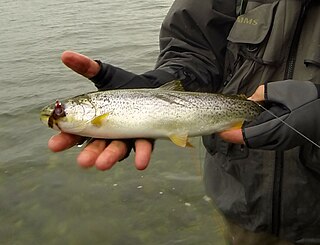
The coastal cutthroat trout, also known as the sea-run cutthroat trout, blue-back trout or harvest trout, is one of the several subspecies of cutthroat trout found in Western North America. The coastal cutthroat trout occurs in four distinct forms. A semi-anadromous or sea-run form is the most well known. Freshwater forms occur in both large and small rivers and streams and lake environments. The native range of the coastal cutthroat trout extends south from the southern coastline of the Kenai Peninsula in Alaska to the Eel River in Northern California. Coastal cutthroat trout are resident in tributary streams and rivers of the Pacific basin and are rarely found more than 100 miles (160 km) from the ocean.

DePuy Spring Creek is a three mile long trout fishery located between the Absaroka and Gallatin mountain ranges in Paradise Valley, south of Livingston, Montana. The creek is a small tributary of the Yellowstone River. This fishery supports a population of brown, Yellowstone cutthroat and rainbow trout.
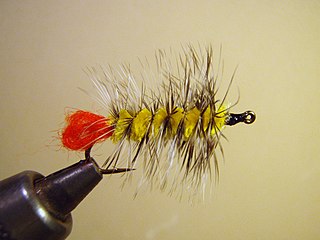
The Woolly Worm is an artificial fly commonly categorized as a wet fly or nymph and is fished under the water surface. It is a popular pattern for freshwater game fish and was a very popular fly in the 1950s–1970s in the west. Charles Brooks in Nymph Fishing for Larger Trout recommends the Woolly Worm as a general purpose nymph pattern in most western trout waters in any fly box. Woolly Worms are typically fished in streams, rivers, ponds, and lakes for trout, bass, and panfish. Today, Woolly Worms are tied in a variety of styles and colors to imitate a large aquatic nymphs such as stoneflies, dragonflies, damselflies or hellgrammites.
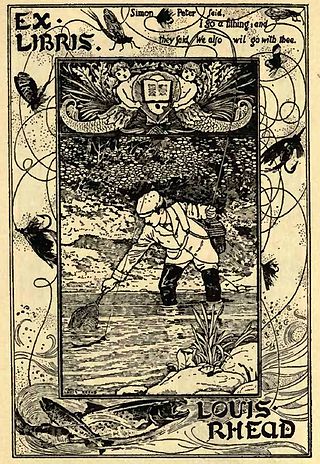
This general annotated bibliography page provides an overview of notable and not so notable works in the English language regarding the sport of fly fishing, listed by year of first publication. Although not all the listed books are devoted exclusively to fly fishing, all these titles contain significant fly fishing content. The focus of the present page is on classic general texts on fly fishing and its history, together with notable public or university library collections dedicated to fly fishing.

Angling in Yellowstone National Park is a major reason many visitors come to the park each year and since it was created in 1872, the park has drawn anglers from around the world to fish its waters. In 2006, over 50,000 park fishing permits were issued to visitors. The park contains hundreds of miles of accessible, high-quality trout rivers containing wild trout populations—over 200 creeks, streams and rivers are fishable. There are 45 fishable lakes and several large lakes are easily accessible to visitors. Additionally, the park's remote sections provide anglers ample opportunity to visit rivers, streams, creeks and lakes that receive little angling pressure. With the exception of one specially designated drainage, all the park's waters are restricted to artificial lures and fly fishing. The Madison, Firehole and a section of the Gibbon rivers are restricted to fly fishing only.
This page is a list of fishing topics.

Dan Bailey was a fly-shop owner, innovative fly developer and staunch Western conservationist. Born on a farm near Russellville, Kentucky, Bailey is best known for the fly shop he established in Livingston, Montana in 1938. Dan Bailey's Fly Shop is still in business.
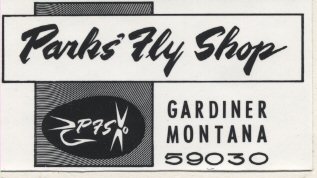
Parks' Fly Shop is a fly shop and licensed fly fishing outfitter in Gardiner, Montana. In business since 1953, the shop located at 202 2nd Street between Main and Stone is the oldest business in Gardiner under continuous family ownership.
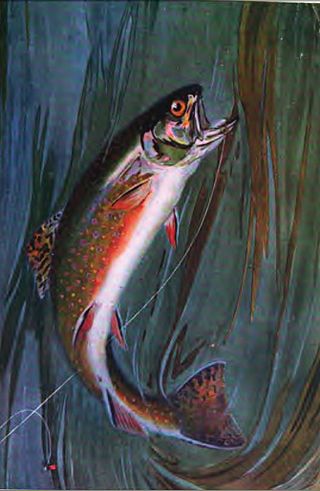
This annotated bibliography is intended to list both notable and not so notable works of English language, non-fiction and fiction related to the sport of fly fishing listed by year published. Although 100% of any book listed is not necessarily devoted to fly fishing, all these titles have significant fly fishing content. Included in this bibliography is a list of species related fly fishing literature.

This annotated bibliography is intended to list both notable and not so notable works of English language, non-fiction and fiction related to the sport of fly fishing listed by year published. Although 100% of any book listed is not necessarily devoted to fly fishing, all these titles have significant fly fishing content. Included in this bibliography is a list of fly tying, fly tackle, regional guides, memoirs, stories and fly fishing fiction related literature.
Fly Fishers International (FFI) is an international 501(c)(3) non-profit organization headquartered in Livingston, Montana. It was founded in 1964 and formalized a year later in 1965. FFI is an organized voice for fly fishers around the world; they represent all aspects of fly fishing, which include the art of fly tying, casting, and protection of the natural systems that support healthy fisheries and their habitats. Today, the organization's goals are to ensure the legacy of fly fishing worldwide. They focus on conservation, education and a sense of community.

Class A Wild Trout Waters are the highest biomass class given to streams in Pennsylvania by the Pennsylvania Fish and Boat Commission. They are considered to contain the highest-quality naturally reproducing trout populations in Pennsylvania. The first streams received their Class A Wild Trout Waters designations in 1983. There are now hundreds of such waters, comprising nearly 1,500 miles (2,400 km) of streams. Class A Wild Trout Waters receive certain legal protections. For instance, they are typically classified by the Pennsylvania Department of Environmental Protection as High-Quality Coldwater Fisheries. Most Class A Wild Trout Waters are subject to standard statewide angling regulations by the Pennsylvania Fish and Boat Commission.

The Wulff series of dry flies evolved from a dry fly style conceived by angler Lee Wulff in the 1930s.
References
- ↑ Utah Blue Ribbon Fisheries Archived May 16, 2008, at the Wayback Machine
- ↑ Michigan's Blue Ribbon Trout Streams
- ↑ Missouri Department of Conservation Archived October 8, 2008, at the Wayback Machine
- ↑ "MFWP Stream Fishery Classification". Archived from the original on 2011-04-17. Retrieved 2011-05-17.
- ↑ Map of Utah's Blue Ribbon Fisheries Archived May 16, 2008, at the Wayback Machine
- ↑ Wisconsin Trout Streams Archived July 17, 2009, at the Wayback Machine
- ↑ "Stream Classification and Mitigation". Wyoming Game and Fish Department. Archived from the original on 2016-01-06. Retrieved 2019-11-14.

